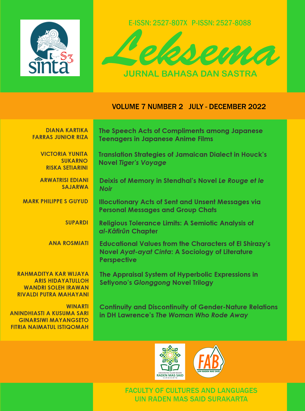ILLOCUTIONARY ACTS OF SENT AND UNSENT MESSAGES VIA PERSONAL MESSAGES AND GROUP CHATS
DOI:
https://doi.org/10.22515/ljbs.v7i2.5368Keywords:
speech act, illocutionary, conversational implicature, unsent messagesAbstract
New features of communication technology are gaining much attention in computer-mediated communication in relation to speech acts and conversational implicatures which aim to transcend the conventional and nonconventional meaning of words, phrases, or sentences when an interlocutor conveys messages in varied contexts. By examining 30 exchanges and conducting survey interviews, this study concerns the illocutionary acts of sent and unsent messages both in personal messages and group chats via an online messaging application. The findings show that there are 7 identified meanings of unsent messages; moreover, although there are similarities, the meaning varies depending on the context. The study also shows that students use representatives more frequently than the other illocutionary acts in sent messages both in personal and group chats. It is also noteworthy to point out that students rarely use greeting speech acts in their messages.
Downloads
References
Adjei, Stephen Baffour. 2013. “Discourse Analysis: Examining Language Use in Context”. TQR (The Qualitative Report) 18 (25): 1-10
Antaki, Charles. 2008. “Discourse Analysis and Conversation Analysis”. In Pertti Alasuutari. Leonard Bickman & Julia Brannan. (eds.). The SAGE Handbook of Social Research Methods, London: Sage: 431-446
Austin, John L. 1962. How to Do Things with Words. Oxford: Oxford University Press
Bach, Kent. 1998. “Speech Acts”. in Edward Craig (ed.) Routledge Encyclopedia of Philosophy. London: Routledge
Bahing, et al. 2018. “English Speech Acts of Illocutionary Force in Class Interaction”. Advances in Language and Literary Studies 9 (3): 113-120
Baron, Reuben M & David A Kenny. 1986. “The Moderator–mediator Variable Distinction in Social Psychological Research: Conceptual, Strategic, and Statistical Considerations”. Journal of Personality and Social Psychology 51 (6): 1173-1182
Barreto, Manuela, Russell Spears, Naomi Ellemers & Khosrow Shahinper. 2003. “Who Wants to Know? The Effect of Audience on Identity Expression among Minority Group Members”. British Journal of Social Psychology 42 (2): 299-318
Bayat, Nihat. 2013. “A Study on the Use of Speech Acts”. Procedia - Social and Behavioral Sciences 70: 213-221
Baym, Nancy K. 1995. “The Emergence of Community in Computer-mediated Interaction”. In Steven G Jones (ed.). In Cybersociety: Computer-Mediated Communication and Community: 138-163. Thousand Oaks: Sage Publication
Calculator, Stephen N. 2009. “Augmentative and Alternative Communication (AAC) and Inclusive Education for Students with the Most Severe Disabilities”. International Journal of Inclusive Education 13 (1): 93-113
Davies, Rory. 2005. “Implicatures and the Cooperative Principle”. Language and Culture. Nagoya: Aichi University. https://taweb.aichi-u.ac.jp/tgoken/bulletin/pdfs/NO22/ 01DAVIES.indd.pdf
Erickson, Thomas & Wendy A Kellogg. 2003. “Social Translucence: Using Minimalist Visualizations of Social Activity to Support Collective Interaction”. In Kristina Hook, David Benyon & Alan Munro (eds.), Designing Information Spaces: The Social Navigation Approach: 17-42. New York: Springer
Grice, Paul. 1989. Studies in the Way of Words. Harvard: Harvard University Press
Hall, Jeffrey A, Natalie Pennington, Allyn Lueders. 2014. “Impression Management and Formation on Facebook: A Lens Model Approach”. New Media & Society 16: 958-982
Hickey, Raymond. 2001. “Language Change”. Handbook of Pragmatics 14: 1-38. Amsterdam: John Benjamins Publishing Company
Hidayat, Agus. 2016. Speech Acts: “Force behind Words”. English Education: Jurnal Tadris Bahasa Inggris 9 (1): 1-12
Kurdghelashvili, Tinatin. 2015. “Speech acts and politeness strategies in an EFL classroom in Georgia”. World Academy of Science, Engineering and Technology International Journal of Cognitive and Language Sciences 9: 306-309
Lea, Martin & Russell Spears.1995. “Love at First Byte? Building Personal Relationships over Computer Networks”. In Julia T. Wood, & Steve Duck (eds.). Under-studied Relationships: Off the Beaten Track. Understanding Relationship Processes Series 6: 197-233. Thousand Oaks: Sage
Light, Janice & McNaughton, David. 2014. “Communicative Competence for Individuals Who Require Augmentative and Alternative Communication: A New Definition for a New Era of Communication?”. Augmentative and Alternative Communication 30 (1): 1-18
Locke, John L. 2000. “Conversation and Community: Chat in a Virtual World. Lynn Cherny CA: CSLI Publications, 1999. Pp. 369”. Applied Psycholinguistics 21 (1): 152-155
Lund, Shelley K & Janice Light. 2007. “Long-term Outcomes for Individuals Who Use Augmentative and Alternative communication: Part III - Contributing Factors”. Augmentative and Alternative Communication 23 (4): 323-335
McKenna, Katelyn YA, Amie S Green, & Marci EJ Gleason. 2002. “Relationship Formation on the Internet: What’s the Big Attraction?”. Journal of Social Issues 58(1): 9-3
Nastri, Jacqueline, Jorge Pena & Jeffrey T Hancok. 2006. “The Construction of Away Messages: A Speech Act Analysis”. Journal of Computer-Mediated Communication 11: 1025-1045
Qiu, Lin, Han Lin, Jonathan Ramsay & Fang Yang. 2012. “You Are What You Tweet: Personality Expression and Perception on Twitter”. Journal of Research in Personality 46 (6): 710-718
Ryabova, Marina. 2015. “Politeness Strategy in Everyday Communication”. Procedia - Social and Behavioral Sciences 206: 90-95
Sioson, I. 2011. “Anobatalagaang “ano”?: Exploring the Meanings of “ano” in Conversations”. Philippine ESL Journal 6
Spears, Russell & Martin Lea. 1994. “Panacea or Panopticon? The Hidden Power of Computer-mediated Communication”. Communication Research 21: 427-459
Tong, Stephanie, Elena F Corriero, Kunto Adi Wibowo & Taj W Makki. 2019. “Self-Presentation and Impressions of Personality through Text-based Online Dating Profile: A Lens Model Analysis”. New Media & Society 22 (3): 875-895
Downloads
Published
Issue
Section
License
Copyright (c) 2022 Leksema: Jurnal Bahasa dan Sastra

This work is licensed under a Creative Commons Attribution-NonCommercial-ShareAlike 4.0 International License.
The copyright of the received article shall be assigned to the publisher of the journal. The intended copyright includes the right to publish the article in various forms (including reprints). The journal maintains the publishing rights to published articles.
In line with the license, the authors and users (readers or other researchers) are allowed to share and adapt the material only for non-commercial purposes. In addition, the material must be given appropriate credit, provided with a link to the license, and indicated if changes were made. If authors remix, transform or build upon the material, authors must distribute their contributions under the same license as the original.







